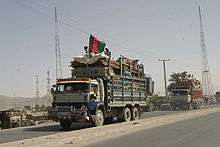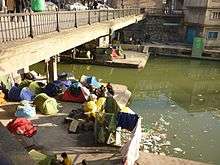Afghan refugees


Afghan refugees are Afghanistan nationals who fled their country as a consequence of the long-going Afghan conflict, lasting since 1978. Ever since the Soviet invasion of Afghanistan, refugees have fled into the surrounding states. After the Soviets left, civil war, Taliban conquest, and most recently the Western-led invasion after September 11, 2001 have meant constant warfare in Afghanistan. Millions have fled the violence, then in times of relative peace returned, only to flee again when renewed fighting broke out. About six million Afghan refugees have fled to neighboring Pakistan (mainly Khyber Pakhtunkhwa province) and Iran, making Afghanistan the largest refugee-producing country in the world, a title it has held for 32 years.[1] The mass majority of Afghan refugees (95%) are located in either Iran or Pakistan.[1] Some NATO countries that were part of the NATO forces took in refugees or Afghans that worked with their respective forces.[2] Ethnic minorities, like Afghan Sikhs and Hindus, often fled to India.[3]
In 2013-2014, 2.4 million Afghan refugees were living in Iran, with only 0.8 million of them being registered as migrants who entered legally.[4] Similarly 1.5 million officially registered Afghan refugees were reported to be living in Pakistan in addition to approximately one million more unregistered refugees.[5][6]
In December 2014, there was a terrorist attack on a school in Peshawar by the Pakistani Taliban, and over 100 school children were killed. Following the attack, Afghan refugees in Pakistan began to encounter serious harassment and often were told to return to Afghanistan. There was a mass exodus of tens of thousands of refugees, which as of February 2015 was ongoing.[7]
Statistics
As shown in the table below, the refugees fled Afghanistan in four main waves:[5][8]
- Soviet war in Afghanistan (1978-89)
- Civil War (1992–96)
- Taliban Rule (1996–2001)
- War in Afghanistan (2001–present)
| Country/Region | Soviet war in Afghanistan (1978-89) | Civil War (1992–96) | Taliban Rule (1996–2001) | War in Afghanistan (2001–present) - Present | |
|---|---|---|---|---|---|
| 3,100,000 [9] | 2,500,000 | [5][6][A 1] | |||
| 3,100,000 [9] | 950,000 - 2,400,000 | [4][10][11][12] | |||
| 300,000 | [13] [A 2] | ||||
| 126,334 | [14] [A 3] | ||||
| 90,000 | [15] [A 4] | ||||
| 56,000 | [16] [A 5] | ||||
| 44,000 | [17] | ||||
| 20,349 | [18] | ||||
| 19,416 | [19] [A 6] | ||||
| 15,854 | [20] [A 7] | ||||
| 18,000 | [21] [A 8] | ||||
| 4,215 [22] [A 9] | 5,390 [22] [A 10] | 10,320 [22] [A 11] | 16,240 | [22] [A 12] | |
| 6,904 | [23] [A 13] | ||||
| 1161 [24] | 15,336 [24] | 3,427 | [24] [A 14] | ||
| 3,500 | [25] | ||||
| 1,750 | [26] [A 15] | ||||
| 4,150 | [27] [A 16] | ||||
See also
References
- Government of Afghanistan (2007). "Embassy of Afghanistan in Sweden". Government of Afghanistan. Retrieved November 7, 2013.
- Associated Press (July 24, 2013). "Tough times follow Afghan refugees fleeing Taliban to Delhi". The Indian Express. Retrieved November 7, 2013.
- Australian Bureau of Statistics (2006). "20680-Ancestry (full classification list) by Sex - Australia". Australian Bureau of Statistics. Retrieved November 7, 2013.
- Bose, Nayana (March 10, 2006). "Afghan refugees in India become Indian, at last". United Nations High Commissioner for Refugees. Retrieved November 7, 2013.
- BBC News (June 19, 2013). "More than seven million refugees displaced in 2012 - UN". BBC News. Retrieved November 5, 2013.
- Carberry, Sean (May 7, 2013). "Afghan-Pakistani Forces Exchange Fire Along Shared Border". NPR. Retrieved November 8, 2013.
- Erlich, Aaron (July 2006). "Tajikistan: From Refugee Sender to Labor Exporter". Migration Policy Institute. Retrieved November 7, 2013.
- Haug, Dr. habil. Sonja; Müssig, Stephanie M.A. & Dr. Anja Stichs (2009). Bundesamt für Flüchtlinge und Migration : Muslimisches Leben in Deutschland (in German) (2009 ed.).
- Iqbal, Mohamed (July 7, 2012). "Kabul looks to Qatar support at aid meet". The Peninsula. Retrieved November 7, 2013.
- Jones, Sophie (July 2010). "Afghans in the UK" (PDF). Information Centre about Asylum and Refugees. Retrieved November 6, 2013.
- National Geographic Society (2013). "Afghan Migration after the Soviet Invasion" (PDF). National Geographic Society. Retrieved November 8, 2013.
- Nordland, Rod (November 20, 2013). "Afghan Migrants in Iran Face Painful Contradictions but Keep Coming". The New York Times. Retrieved November 22, 2013.
- Shahbandari, Shafaat (November 30, 2012). "Afghans take hope from UAE's achievements". Gulf News. Retrieved November 5, 2013.
- Stainburn, Samantha (May 22, 2013). "UK, Denmark to give Afghan interpreters visas". GlobalPost. Retrieved November 5, 2013.
- Statistics Canada (2006). "Immigrant population by place of birth and period of immigration (2006 Census)". Statistics Canada. Retrieved November 7, 2013.
- United Nations High Commissioner for Refugees (2005). "UNHCR Global Report 2005: Turkey" (PDF). United Nations High Commissioner for Refugees. Retrieved November 7, 2013.
- United Nations High Commissioner for Refugees Iran (2013). "2013 UNHCR country operations profile - Islamic Republic of Iran". United Nations High Commissioner for Refugees. Retrieved November 6, 2013.
- United Nations High Commissioner for Refugees (February 12, 1999). "Afghanistan 10 years after Soviet pull-out". United Nations High Commissioner for Refugees. Retrieved November 5, 2013.
- United Nations High Commissioner for Refugees (2013). "2013 UNHCR country operations profile - Pakistan". United Nations High Commissioner for Refugees. Retrieved November 5, 2013.
- United States Census Bureau (2013). "2011 American Community Survey 1-Year Estimates". United States Census Bureau. Retrieved November 5, 2013.
- 1 2 BBC News 2013
- ↑ Stainburn 2013
- ↑ Bose 2006
- 1 2 Central Intelligence Agency. The CIA World Factbook 2015. Skyhorse Publishing, Inc., 4 nov. 2014 ISBN 1629149039
- 1 2 3 Nordland 2013
- 1 2 United Nations High Commissioner for Refugees 2013
- ↑ Joseph Goldstein (February 23, 2015). "Refugees Are Pushed to Exits in Pakistan". The New York Times. Retrieved February 24, 2015.
they all say they have been beaten and slapped and told nobody in Pakistan wants them anymore
- ↑ National Geographic Society 2013, p. 1
- 1 2 United Nations High Commissioner for Refugees 1999
- ↑ Demographics of Iran
- ↑ UNHC Iran 2015 figures
- ↑ "Afghan refugees in Iran". Retrieved 15 May 2014.
- ↑ Shahbandari 2012
- ↑ Haug & Müssig 2009, p. 76 chart 5
- ↑ United States Census Bureau 2013
- ↑ Jones 2010, p. 2
- ↑
- ↑
- ↑ Australian Bureau of Statistics 2006
- ↑ Denmark Bureau of Statistics 2014
- ↑ Associated Press 2013
- 1 2 3 4 Statistics Canada 2006
- ↑ Government of Afghanistan 2007
- 1 2 3 Erlich 2006
- ↑ bq magazine - Qatar´s population by nationality
- ↑ UNHCR - Syrian Arab Republic
- ↑ United Nations High Commissioner for Refugees 2005, p. 393